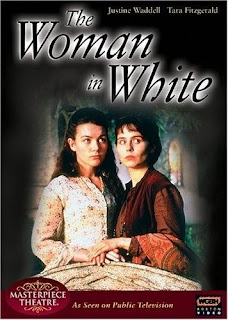The Woman in White (1997)
Wilkie Colllins' novel The Woman in White (see below) has been adapted many times, including a few silent film versions, a Hollywood film from 1948, and an Andrew Lloyd Webber musical. The only available version to me is a 1997 Masterpiece Theater adaptation that shows how not to adapt a classic novel.
Collins' novel is long and complex and almost all plot. This version, directed by Tim Fywell, is just under two hours long, and while it is acceptable and expected to see a truncated version of the book, this film makes some changes that seem arbitrary.
Having the book so fresh in my mind it's difficult to be objective. Had I not read the book, I would have found this film sluggish and curiously mean-spirited, with good characters acting much more aggressively than they do in the novel.
To summarize, two half-sisters (Tara Fitzgerald and Justine Waddell) live in a country estate in the north of England (here they share a father, while in the book they share a mother). A drawing teacher (Andrew Lincoln) arrives, and on his walk to the estate from the train station he encounters a woman dressed all in white who acts strange. Amazingly, unlike the book, he does not learn that she has escaped from an asylum (in the book, he encounters her in London).
Lincoln falls in love with Waddell, but she affianced to a local baronet (James Wilby). Unlike the book, where the drawing teacher leaves because it is the gentlemanly thing to do, the film has him framed for molesting a maid.
Wilby, who appears to be a first-class gentleman, soon reveals himself as a cad. Waddell returns from her honeymoon and tells her sister that she fears he will kill her for her money. Soon an Italian count (Simon Callow), saying he is Wilby's cousin, arrives. He appears to be on Waddell's side, but also soon is revealed as a villain (in the book, he is the sisters' uncle by marriage, but here he is a hired confederate).
The main difference is the shift of focus from Walter Hartright, the drawing teacher, to Marian (Fitzgerald). She is protagonist and goes through some hardships unseen in the book. A death of a major character is also changed and sensationalized, and a character who dies in a fire is changed from an accident and gallant behavior by the drawing teacher to out-and-out murder. Also, a huge section on Fosco's comeuppance is excised. Russell Baker, the host of Masterpiece Theater, explains that that would have taken another hour to dramatize. True, but why stint? If you're going to make a film of the book, why do it at half measure?
A BBC miniseries of five episodes was made in 1982, I assume that is much more on the mark. I'm curious to see the 1948 film, if only because Fosco is played by Sidney Greenstreet. No one would mistake him for an Italian, but physically he is much more in line with the character as described by Collins.
Collins' novel is long and complex and almost all plot. This version, directed by Tim Fywell, is just under two hours long, and while it is acceptable and expected to see a truncated version of the book, this film makes some changes that seem arbitrary.
Having the book so fresh in my mind it's difficult to be objective. Had I not read the book, I would have found this film sluggish and curiously mean-spirited, with good characters acting much more aggressively than they do in the novel.
To summarize, two half-sisters (Tara Fitzgerald and Justine Waddell) live in a country estate in the north of England (here they share a father, while in the book they share a mother). A drawing teacher (Andrew Lincoln) arrives, and on his walk to the estate from the train station he encounters a woman dressed all in white who acts strange. Amazingly, unlike the book, he does not learn that she has escaped from an asylum (in the book, he encounters her in London).
Lincoln falls in love with Waddell, but she affianced to a local baronet (James Wilby). Unlike the book, where the drawing teacher leaves because it is the gentlemanly thing to do, the film has him framed for molesting a maid.
Wilby, who appears to be a first-class gentleman, soon reveals himself as a cad. Waddell returns from her honeymoon and tells her sister that she fears he will kill her for her money. Soon an Italian count (Simon Callow), saying he is Wilby's cousin, arrives. He appears to be on Waddell's side, but also soon is revealed as a villain (in the book, he is the sisters' uncle by marriage, but here he is a hired confederate).
The main difference is the shift of focus from Walter Hartright, the drawing teacher, to Marian (Fitzgerald). She is protagonist and goes through some hardships unseen in the book. A death of a major character is also changed and sensationalized, and a character who dies in a fire is changed from an accident and gallant behavior by the drawing teacher to out-and-out murder. Also, a huge section on Fosco's comeuppance is excised. Russell Baker, the host of Masterpiece Theater, explains that that would have taken another hour to dramatize. True, but why stint? If you're going to make a film of the book, why do it at half measure?
A BBC miniseries of five episodes was made in 1982, I assume that is much more on the mark. I'm curious to see the 1948 film, if only because Fosco is played by Sidney Greenstreet. No one would mistake him for an Italian, but physically he is much more in line with the character as described by Collins.



Comments
Post a Comment